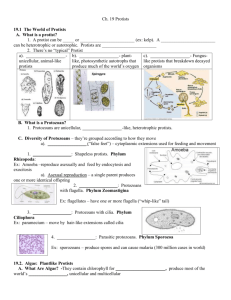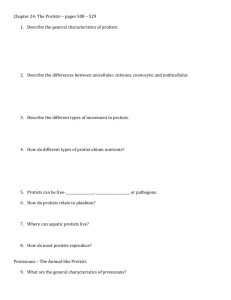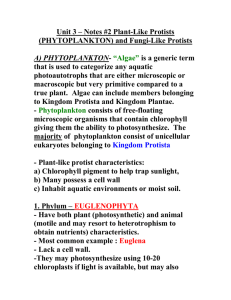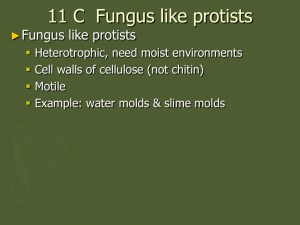Kingdom Protista “ The Catch
advertisement
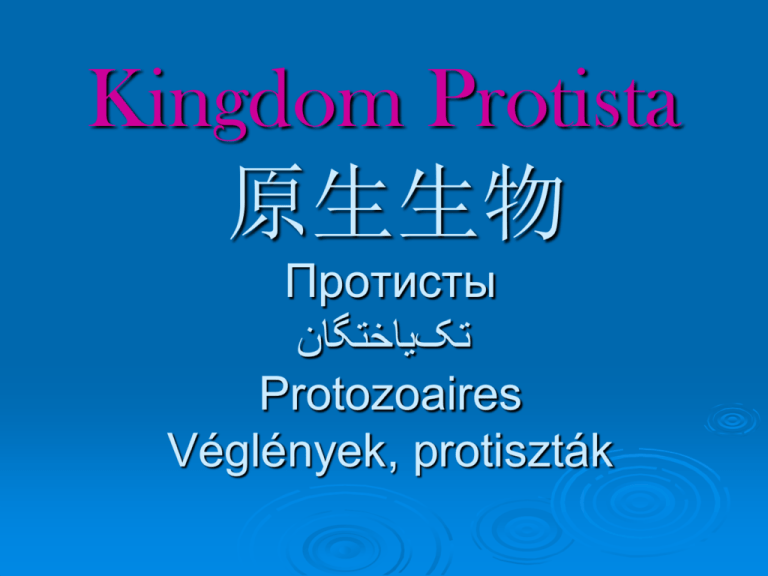
Kingdom Protista 原生生物 Протисты تکیاختگان Protozoaires Véglények, protiszták Protist Diversity 200,000 species come in different shapes, sizes, and colors All are eukaryotes – have a nucleus and membrane-bound organelles Evolution of Protista – 3.5 billion years ago Eukaryotes – 1.5 billion years ago Protozoan thought to be descendents of first eukaryotes Endosymbiotic Theory Prokaryotes Endosymbiotic Theory The endosymbiotic theory concerns the origins of mitochondria and plastids (e.g. chloroplasts), which are organelles of eukaryotic cells. According to this theory, these organelles originated as separate prokaryotic organisms that were taken inside the cell as endosymbionts. Mitochondria developed from proteobacteria (in particular, Rickettsiales or close relatives) and chloroplasts from cyanobacteria. Protists The world of Protists: Animal-like Protists (Protozoans) Plant-like Protists Fungus-like Protists Protists The world of Protists: Animal-like Protists (Protozoans) Plant-like Protists (Algae) Fungus-like Protists Protozoans Animal-like Protists Characteristics of Protozoans Single celled Microscopic Move independently – named for mechanism of movement 65,000 species Most heterotrophic Free-living or parasitic All capable of asexual reproduction through binary or multiple fission Some reproduce sexually through conjugation Protozoans Unicellular – made up of one cell Heterotrophs – they eat other organisms or dead organic matter Classified by how they move Phyla of Protozoans Amoebas Flagellates Ciliates Sporazoans Classification Currently based on HOW they MOVE Reviewing this by looking at phylogeny 4 Phyla of Protozoans Sarcodina (Amoebas) Ciliophora (Paramecium) Zoomastigina () Sporozoa () Adaptations Physiological mechanisms, like eyespots Form cysts Multiple nuclei Sexual reproduction Asexual reproduction Binary fission Schizogony Asexual reproduction in multiple fission, as in Malaria Phylums… Sarcodina 40,000 species Amoebas Pseudopodia – most move Cytoplasmic streaming Eat other protists Ecological roles: forams – tests made from caco3 – sink to bottom and make limestone and chalk deposits Radiolaria – t4ests made form sio2 Cause diseases like amebic dysentary Amoebas: the blobs No cell wall Move using pseudopods – plasma extensions Engulf bits of food by flowing around and over them Phylum Ciliophora 8,000 species Move using cilia Pellicle, oral groove, gullet, macronucleus, micronucleus Paramecium Ciliates: the hairy ones Move beating tiny hairs called cilia Phylum Zoomastigina 2,500 species Move using flagella Most free-living Cause disease – zooflagellates African trypanosomiasis – sleeping sickness – tsetse fly Chagas Disease – kissing bug Leishmaniasis – sand fly giardiasis Flagellates: the motorboats Use a whip-like extension called a flagella to move Some cause diseases Trichomonas foetus : cow disease Trichomonas vaginalis: an STD The tsetse fly – sleeping sickness vector The Kissing Bug Leishmaniasis Phylum Sporozoa 6,000 species Carried in blood Cause disease like toxoplasmosis and malaria Know malaria cycle!!!! Sporazoans: the parasite Non-motile - Do not move Live inside a host One type causes malaria Malaria in red blood cells Pneumonia in aids patients Algae Plantlike Protists What are Algae? Multicellular – made of more than one cell Photosynthetic – make their own food No roots, stems, or leaves Each has chlorophyll and other photosynthetic pigments Characteristics of Algae Autotrophic plants – why? Often contain pyrenoids Not centers of carbon dioxide fixation within the chloroplasts of algae and hornworts. Pyrenoids are not membrane-bound Structure of Algae Thallus or body Unicellular or multicellular Colonial: Volvoz Filamentous: Spirogyra Multicellular: Ulva Asexual and sexual reproduction Phyla of Algae Euglenoids (Phylum Euglenophyta) Diatoms (Phylum Bacillariophyta) Dinoflagellates (Phylum Dinoflagellata) Red Algae Brown Algae (Phylum Phaeophyta) Green Algae (Phylum Chlorophyta) Golden Algae (Phylum Chrysophyta) Euglenoids: The Survivors Aquatic Move around like animals Can ingest food from surroundings when light is not available Phylum Euglenophyta Euglenoids Plant-like and animal-like characteristics Many have cholorphyll and are photosynthetic No cell wall, motile Most live in fresh water Diatoms: The Golden Ones Have shells made of silica (glass) Photosynthetic pigment called carotenoids – give them a golden color Phylum Bacillariophyta Diatoms Shells fit together like a box with a lid Centric and pennate Main component of phytoplankton Diatomaceous earth Diatoms are dominant members of the phytoplankton that can be caught in a net. They are especially common in temperate , coastal and polar regions. They have sculptured shells, or frustules, made of silica. Diatoms can come in a variety of shapes. More Diatom Shapes Life Cycle of a Diatom Fish Killer Some diatoms, like this one can kill fish when found in large numbers The glasslike projections cause mucus to build up in the fish’s gill which can lead to the fish's death. Dinoflagellates: The Spinning Ones Spin around using two flagella Responsible for Red Tides Create toxins that can kill animals and sometimes people Phylum Dinoflagellata Dinoflagellates Small, unicellular Most photosynthetic Some bioluminescent Red tide a problem Dinoflagellates Dinoflagellates are found throughout the world’s oceans, but tend to prefer warmer areas. Given nutrients, dinoflagellates can bloom or explosively grow to huge numbers sometimes causing RED TIDES Dinoflagellates: red tides Florida red tide organism: Gymnodinium breve Around 60 species of Dinoflagellates are known to cause red tides. A few species produce poisons that are among the most powerful natural toxins known. During a red tide, dinoflagellates may poison the waters, turning the surface into a sea of dead fish. Red tides can also threaten human health. Mussels, clams and other bivalves store the toxins as they filter feed. People who eat the shellfish can get Paralytic Shellfish Poisoning. Victims suffer numbness and tingling, loss of balance, slurred speech, and in extreme cases, paralysis and death! Symbiotic Dinoflagellates Some dinoflagellates like Zooxanthellae, are symbiotic with corals or jellyfish. Red Algae: The…uh…Red Ones (duh) Seaweeds Multicellular, marine organisms Have red and blue pigments Phylum Rhodophyta Red algae but colors vary Marine seaweeds Smaller than brown algae and live in deeper waters Phycobilins – pigment for absorbing light Some coated with polysaccharide carageenan – cosmetics, gel capsules, cheeses Agar – extracted from cell walls of red algae Brown Algae: The Brown Ones (You think?) They have air bladders to help them float at the surface – where the light is. Brown algae Phylum Phaeophyta Marine Seaweed and kelps Cooler areas of ocean Fucoxanthin pigment Store food as laminarin ALL multicellular Stemlike stipe Leaflike region called blade Green Algae: Yeah, You Guessed it, The Green Ones Most live in fresh water Can be unicellular or multicellular Live alone or in groups called colonies Phylum Chlorophyta Look familiar? Continued… Green algae Many different forms Gave rise to land plants – why? Choroplasts that contain a and b cholorphyll Have carotenoids Cell walls of cellulose Ulva Colonial Chlorophyta Golden Algae Phylum Chrysophyta Most fresh water Form cysts 2 flagella Carotenoids give color Important for formation of petroleum deposits Fungus-like Protists Characteristics in Common All form delicate, netlike structures on the surface of their food source Obtain energy by decomposing organic material Fungus-like protists Slime molds: Phylum acrasiomycota Cellular slime molds Amoeboid movement Water molds Phylum Oomycota Blight Phylum Myxomycota Plasmodial slime molds Mass of plasmodium Phylum Chytridiomycota Chytrids Zoospores with one flagellum Maybe fungi? Slime molds Water molds Chytrids Phyla of Fungus-like Protists Plasmodium Slime Molds Cellular Slime Molds Water Molds & Downy Mildews Slime Molds Live in cool moist, shady places where they grow on damp, organic matter Plasmodium Slime Molds Form plasmodium: a mass of cytoplasm that contains many diploid nuclei but no cell walls or membranes – its feeding stage Creeps by amoeboid movement – 2.5 cm/hour Plasmodium continued… May reach more than a meter in diameter Form reproductive structures when surroundings dry up Spores are dispersed by the wind and grow into new plasmodium Cellular Slime Molds In feeding mode, they exist as individual amoebic cells When food becomes scarce, they come together with thousands of their own kind to reproduce May look like a plasmodium Water Molds and Downy Mildews Live in water or moist places Feed on dead organisms or parasitize plants Fuzzy white growths
